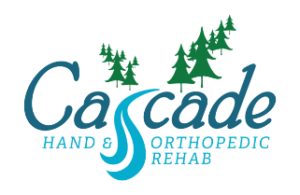Effective Shoulder Exercises for Pain Relief and Flexibility

Are you living with persistent shoulder pain and stiffness? Whether you’re an athlete who recently injured their rotator cuff or an office worker who developed osteoarthritis, one technique can help you manage your shoulder discomfort: exercise. Targeted shoulder pain exercises can help reduce pain and restore mobility.
Shoulder pain is relatively common, and women are more likely to experience it than men. However, exact numbers can be difficult to pinpoint, as shoulder pain can result from any number of different conditions.
Regardless, studies show that therapeutic exercise is one of the most effective ways to address shoulder pain and stiffness. While some conditions require surgery to repair, many more can be addressed through noninvasive measures, ensuring you find the relief you need without undergoing a risky procedure.
At Cascade Hand & Orthopedic Rehab, our FL-based team of hand and occupational therapists have extensive experience helping people of all types manage their shoulder pain. We can provide a personalized exercise program to help you see results.
Want to learn more about the role of exercise in managing shoulder discomfort? Call our clinic to schedule an appointment today!
What Conditions Cause Shoulder Pain?
Before you can begin addressing shoulder pain, you need to understand what’s causing it in the first place. Your shoulder is a complex structure that can perform an incredible array of movements–but that also means many things can go wrong.
Experts generally place shoulder pain into four broad categories. If you’re struggling with shoulder discomfort, it likely falls into one of them. Our team can let you know for sure.
- Tendinopathy: This term refers to any issues with your tendons, including inflammation (tendinitis) or tears in the tissue. It can also include bursitis, which refers to the inflammation of the bursae, small fluid-filled sacs located through your shoulder joint.
- Arthritis: Arthritis is an umbrella term for several conditions that cause inflammation in the body’s joints. Osteoarthritis is the most common and can affect the shoulder, causing pain, stiffness, and swelling.
- Dislocation: Your shoulder is a ball and socket joint. A dislocation occurs when the “ball” part of the joint slips out of its socket, either partially or completely. What causes this to happen in the first place? It’s generally related to stretched or torn soft tissue (muscles, ligaments, or tendons) in the shoulder.
- Fracture: Finally, broken bones–typically the collarbone, upper arm, or shoulder blade –will obviously cause shoulder pain. While our therapists can’t treat a fracture, we can help you rehabilitate afterward.
Shoulder pain exercises are an effective way to manage the impairment and discomfort of all of these conditions. Even in cases where you may need surgical or other medical interventions, a hand-therapist-guided exercise program is crucial to helping you rebuild your strength and mobility.
Designing a Good Shoulder Pain Exercise Program
When you visit Cascade Hand & Orthopedic Rehab for treatment, we’ll develop a personalized exercise program based on your condition, symptoms, and ability level. These programs are progressive, meaning we’ll start with gentle movements, then gradually build the intensity as you improve.
A good rehabilitation exercise program will focus on two things:
- Strength: Strong muscles ensure a strong shoulder joint. When you build strength in the muscles of your upper back, shoulder, and upper arm, you provide great support and stability to the joint itself–which not only helps resolve injury and pain but can help prevent future injury, too.
- Stretching and Mobility Work: In addition to building or restoring strength, you also want to increase your shoulder’s flexibility and range of motion. We’ll show you gentle stretches to perform after your workout.
Our team will also help prepare your body for exercise. Therapeutic exercise may be intimidating for someone struggling with intense pain, where even gentle exercises may feel impossible. One thing we can do is help with acute management before you begin your regime, using drug-free pain relief approaches like manual therapy or pain relief modalities.
A Few of the Shoulder Pain Exercises We Might Prescribe
Our expert hand and occupational therapists design every treatment program around the needs of our patients, which means every program is different. However, here are a handful of the shoulder exercises we recommend.
Keep in mind that these exercises work best when included as part of a tailored treatment program, and should never be forced, so rather than diving in on your own, schedule an appointment to get a personalized plan–not to mention our team’s expert guidance!
- Pendulum Exercises: This is an excellent example of a gentle exercise for someone with a great deal of pain and limited mobility. It involves bracing the uninjured arm against a table while using your body to create a gentle swinging movement of the injured arm forward and back, side to side, and in small clockwise and counterclockwise circles.
- Gentle Passive Rotations: These two exercises use a light stick to help you passively stretch your shoulder. While standing, keep your elbows bent to 90 degrees and hold the stick horizontally with both hands in front of you. Then gently glide it side to side while maintaining the 90-degree elbow bend.
- Standing Row: As you build strength, we may incorporate resistance bands to challenge your muscles. This exercise involves pulling back on a resistance band with both hands, your elbows bent and at your sides.
- More Challenging Internal and External Rotations: Your program will also build on movements you performed in the early stages. For example, we’ll incorporate free weights into the basic internal and external rotation movement once you’re strong enough.
For these exercises, you’ll lie on your side with your upper arm touching your torso. You’ll hold a light weight in your hand while keeping your elbow at a 90-degree angle. Then you’ll rotate upward (external rotation) or downward (internal rotation).
Want to Get Started? Make an Appointment!
The exercise list provided here is just a small sample of what the hand and occupational therapists at Cascade Hand & Orthopedic Rehab can provide for you. If you’re struggling with shoulder pain, request an appointment at our FL clinic today for your very own custom shoulder pain exercise program!
Sources:
- https://orthoinfo.aaos.org/en/recovery/rotator-cuff-and-shoulder-conditioning-program/
- https://www.physio-pedia.com/Therapeutic_Exercise_for_the_Shoulder
- https://orthoinfo.aaos.org/en/diseases–conditions/shoulder-pain-and-common-shoulder-problems/
- https://www.physio-pedia.com/Epidemiology_of_Shoulder_Pain
